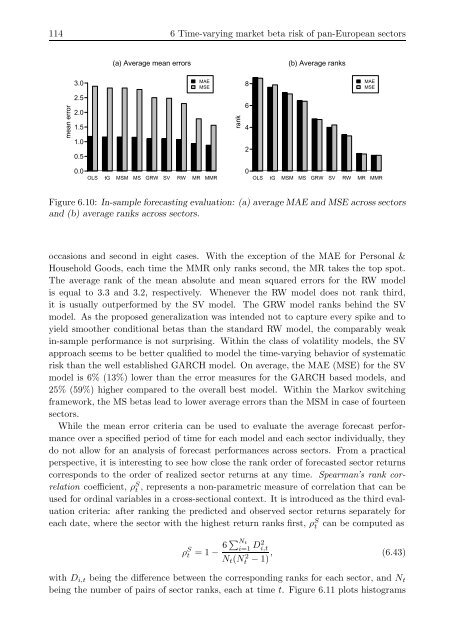Applications of state space models in finance
Applications of state space models in finance
Applications of state space models in finance
You also want an ePaper? Increase the reach of your titles
YUMPU automatically turns print PDFs into web optimized ePapers that Google loves.
114 6 Time-vary<strong>in</strong>g market beta risk <strong>of</strong> pan-European sectors<br />
mean error<br />
3.0<br />
2.5<br />
2.0<br />
1.5<br />
1.0<br />
0.5<br />
(a) Average mean errors<br />
MAE<br />
MSE<br />
0.0<br />
OLS tG MSM MS GRW SV RW MR MMR<br />
rank<br />
8<br />
6<br />
4<br />
2<br />
(b) Average ranks<br />
MAE<br />
MSE<br />
0<br />
OLS tG MSM MS GRW SV RW MR MMR<br />
Figure 6.10: In-sample forecast<strong>in</strong>g evaluation: (a) average MAE and MSE across sectors<br />
and (b) average ranks across sectors.<br />
occasions and second <strong>in</strong> eight cases. With the exception <strong>of</strong> the MAE for Personal &<br />
Household Goods, each time the MMR only ranks second, the MR takes the top spot.<br />
The average rank <strong>of</strong> the mean absolute and mean squared errors for the RW model<br />
is equal to 3.3 and 3.2, respectively. Whenever the RW model does not rank third,<br />
it is usually outperformed by the SV model. The GRW model ranks beh<strong>in</strong>d the SV<br />
model. As the proposed generalization was <strong>in</strong>tended not to capture every spike and to<br />
yield smoother conditional betas than the standard RW model, the comparably weak<br />
<strong>in</strong>-sample performance is not surpris<strong>in</strong>g. With<strong>in</strong> the class <strong>of</strong> volatility <strong>models</strong>, the SV<br />
approach seems to be better qualified to model the time-vary<strong>in</strong>g behavior <strong>of</strong> systematic<br />
risk than the well established GARCH model. On average, the MAE (MSE) for the SV<br />
model is 6% (13%) lower than the error measures for the GARCH based <strong>models</strong>, and<br />
25% (59%) higher compared to the overall best model. With<strong>in</strong> the Markov switch<strong>in</strong>g<br />
framework, the MS betas lead to lower average errors than the MSM <strong>in</strong> case <strong>of</strong> fourteen<br />
sectors.<br />
While the mean error criteria can be used to evaluate the average forecast performance<br />
over a specified period <strong>of</strong> time for each model and each sector <strong>in</strong>dividually, they<br />
do not allow for an analysis <strong>of</strong> forecast performances across sectors. From a practical<br />
perspective, it is <strong>in</strong>terest<strong>in</strong>g to see how close the rank order <strong>of</strong> forecasted sector returns<br />
corresponds to the order <strong>of</strong> realized sector returns at any time. Spearman’s rank correlation<br />
coefficient, ρS t , represents a non-parametric measure <strong>of</strong> correlation that can be<br />
used for ord<strong>in</strong>al variables <strong>in</strong> a cross-sectional context. It is <strong>in</strong>troduced as the third eval-<br />
uation criteria: after rank<strong>in</strong>g the predicted and observed sector returns separately for<br />
each date, where the sector with the highest return ranks first, ρS t can be computed as<br />
i=1 D2 i,t<br />
Nt(N 2 t − 1)<br />
ρ S t = 1 − 6 � Nt<br />
, (6.43)<br />
with Di,t be<strong>in</strong>g the difference between the correspond<strong>in</strong>g ranks for each sector, and Nt<br />
be<strong>in</strong>g the number <strong>of</strong> pairs <strong>of</strong> sector ranks, each at time t. Figure 6.11 plots histograms

















